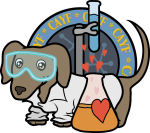I recently joined up with C&EN News to create “Chem-Lapsed.” A series that uses time-lapses to showcase interesting chemical reactions.
The pilot episode features a reaction that is surprisingly not well-known, given its publication in 1986, and the relatively simple ingredients for a chemistry lab — the Tomato Juice Rainbow. It is a really fun demonstration for organic chemistry and spectroscopy!
Has it been a long time since you’ve picked up a chemistry textbook? I’ve explained the Tomato Juice Rainbow below the video, and I am always happy to answer any questions!
Tomato Juice Rainbow Explained
Here is a brief explanation of some of the really interesting things going on here that make this beautiful rainbow happen:
- The most obvious layer is the red layer, which is the tomato juice. The red color is from lycopene, which is a carotenoid like beta-carotene in carrots.
- The yellow color is the result of the chemical reaction between lycopene and bromine (from bromine water.) When bromine (or Br2) adds to lycopene, it removes double bonds, and this process is called oxidation. As the number of double bonds in lycopene decreases, the color of light that it absorbs also changes so that we see yellow instead of red.
- The narrow test tube helps! The thicker parts of the liquid will stick inside the glass towards the bottom, and so the layers with different chemical compositions stay separated in what is called a density gradient.
- There is an interesting stage right before the oxidation is finished, and this is responsible for the blue color seen in the rainbow. This is actually REALLY cool. We are able to see this because the tomato juice is so thick* that it can hold this state long enough for us to see the blue color.
- The green layer is simply from the blue and yellow mixing.
Notes and Contact
Please note: unfortunately this beautiful experiment CANNOT be done in your home and CANNOT be consumed. It must be performed in the safety of a laboratory, and in the hands of an experienced chemist. This is because of the bromine (or Br2) that is added. It is similar to the chlorine that is used to disinfect pools, BUT it is EVEN STRONGER than chlorine! You know how pungent the smell of chlorine is? Well molecular bromine can burn your nose! This demonstration is for the purpose of teaching students about organic chemistry in a more entertaining way than some of the less colorful methods, as well includes some interesting spectroscopy lessons. Of course in this case it is also used as art, but it was done in the hands of a chemist 😉
*note for the science inclined: thick due to the lipid cells, which is what holds the charge transfer state
In case you didn’t catch the link above, you can read the original scientific article by MacBeath and Richardson here.
All content was created by Dorea Reeser for Chemical & Engineering News and are ©C&EN 2015.
If you have any questions about how this experiment was performed, how it was shot, any comments in general, or suggestions for future Chem-Lapsed episodes, Contact Dorea Reeser via: email, Twitter, Facebook, or commenting here
Acknowledgements:
Thanks to Prof. Derek Jackson at York University for suggesting the Tomato Juice Rainbow experiment and for his advice!
Thanks to the University of Toronto, Department of Chemistry for their support and sponsoring this educational shoot
